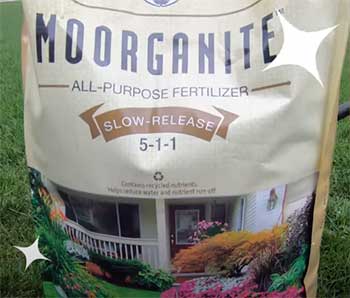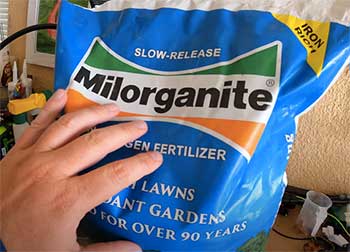Fertilizer is a must for your lawns to keep the grass healthy and green. Grass needs the proper nutrition to grow and be greener.
If you are considering which type of fertilizer you should use for your lawn, natural or not, we have two excellent examples for you to choose from.
Moorganite and Milorganite are two different types of fertilizer and both have a good impression of working great on lawn grasses. One is all-natural and another is biosolid.
To find a good fit for your lawn, we have come up with a detailed comparison and difference note of two of these fertilizers that would help you choose the best fit for your lawn.
A Quick Comparison Table
Here is a brief comparison between Moorganite and Milorganite. You can skim through the table to have a primary understanding of how these two fertilizers work differently and what features make them distinguishable.
| Specification | Moorganite | Milorganite |
| By-product | Dairy cow manure | Wastewater treatment |
| Supply | Steady | Limited |
| NPK Ratio | 5-1-1 | 6-4-0 |
| Type | Natural | Biosolid |
| Service | Better | Good |
| Cost | High | Moderate |
Key Differences Between Moorganite And Milorganite
After understanding the fundamentals of the two types, let’s move on to the specifications.
You can choose which fertilizer is more adaptable for you to employ on your lawn or in your garden by understanding how these two types specifically operate.
- By-product

Both fertilizers come as by-products of different materials. The Milorganite has been going on in the market for a long time now.
It comes as a by-product of wastewater treatment of Milwaukee Sewer.
On the other hand, Moorganite comes as a by-product of dairy cow manure from different dairy farms around the USA.
Both fertilizers are processed finely with other nutrients, which are needed to enrich them to work well as a fertilizer. Both the products and the material inside them work quite well on the grass of your lawn
- Supply
There are hundreds of dairy farms around the USA so dairy cow manure is always in supply to produce fertilizers. That is why the supply of the Moorganite is always steady or available whenever needed.
You can easily get the fertilizer whenever you demand it.
However, the Milorganite fertilizer has quite the opposite scene. The by-product comes from sewers and also needs a lot of processing for its treatment to create the by-product.
That is why, Milorganite fertilizers always have a limited supply, which sometimes becomes very overwhelming for the sellers due to huge customer demands.
Initially, only Milorganite fertilizers were available in the market. But due to huge demand from the customers, the manufacturers thought about using such by-products, which will be available almost always but have similar features to the Milorganite.
Then they chose dairy cow manure as a by-product and created Moorganite all-purpose fertilizer. As there are a lot of dairy farms, getting dairy cow manure was easier for the company than wastewater treatment.
- NPK Ratio

NPK refers to the three different nutrients — Nitrogen (N), Phosphorus (P), and Potassium (K).
By using the fertilizer values, you may determine how much fertilizer has to be used to provide 1 pound of the element you want to the soil.
The ratio of NPK for Moorganite fertilizer is 5-1-1, indicating that the fertilizer contains 5% nitrogen, 1% Phosphorus, and 1% Potassium.
On the other hand, the Milorganite fertilizer has an NPK ratio of 6-4-0. This means it has 6% nitrogen, 4% Phosphorus, and no Potassium inside it.
It is found that the more the percentage of the nutrient, the more concentrated the nutrient is.
Nitrogen would help the grass on your lawn to grow. Phosphorus is responsible for the growth of the roots and their proper development. And Potassium looks after the overall growth and development of the plant.
- Type
Moorganite fertilizers are all-purpose and made of manures of cows. Whereas, Milorganites are biosolid. Manures come from animal wastes in liquid and solid forms which can be both treated and raw.
Manures help in improving the soil quality and make it more fertile. They prevent and protect from any kinds of leaching of the soil and are a good source of macronutrients.
On the other hand, biosolids are organic and highly enriched in nutrients. It also improves the soil structure in a land.
- Service
Both fertilizers give great service to the owners of lawns. But in terms of supply, Moorganite fertilizers are great as the supply rarely stops.
On the other hand, the Milorganite fertilizers have this amazing feature of sustaining for a long time and enhancing the quality of the soil for a long period of time
- Cost
Both fertilizers have standard pricing. However, the Moorganite fertilizers cost more than the Milorganite fertilizers. A Moorganite fertilizer costs from $20 to $30 whereas a Milorganite costs from $10 to $15.
The price difference comes due to the manufacturing process and costs of both fertilizers. The Moorganite fertilizers cost more as their raw materials cost more and it is all-natural.
But the Milorganite fertilizers cost less because their raw materials and processing are a bit cheaper than that of Moorganite fertilizers.
Which One Will Be the Best Fit for Your House?
The answer is quite difficult to decide on as both the fertilizers have been performing so well and have so many good reviews from the users.
Although Moorganite can be an ideal fertilizer for you, even more than Milorganite. Moorganites decompose while Milorganites do not as they contain biosolids, which have toxins that would never decompose.
Watch and see how fantastically it works!
Milorganite fertilizers also lack one of the three main nutrients of the NPK, which is potassium. So, you can consider using it although Milorganite is cheaper in price and enriched in the other two nutrients, nitrogen and phosphorous.
Frequently Asked Questions (FAQ)
Frequently asked questions about Moorganite & Milorganite and our answers.
Milorganite is definitely a better option than Ironite if you want your lawn to have good nutrients and green grass. The former also does not contain any harsh nutrients but Ironite contains concentrated irons. Milorganite is a more natural and enriched product. It is also doing the environment a favor by treating the wastewater.
Moorganite fertilizers are completely organic. They are derived from dairy cows or chicken manure. Sometimes they are used as raw materials on the ground and sometimes they are treated.
An excessive amount of Milorganite forces excessive blade development. As a result, thatch accumulates, suffocates the grass, depletes the soil of moisture, and fosters the growth of fungi.
Forced excessive blade growth results from too much Milorganite. This causes thatch to accumulate, suffocate grass, steal moisture from the soil, and invite fungi. Due to too much nitrogen in the soil, grass might turn brown or yellow.
Of course, Milorganite is a good fertilizer. It is responsible for reducing the slightest possibility of macronutrient runoff as it is well-developed slow-release nitrogen fertilizer. The soil bacteria and plants are both fed by the organic matter that makes up 85% of Milorganite.
This enhances the soil’s capacity to support grass growth. Grass also grows well due to it making the soil a bit acidic and keeping the soil between the pH levels of 7-6.5, in which the grasses can intake nutrients quickly and effectively.
Final Words
Both Milorganite and Moorganite work fantastically as fertilizers. Although one of them seems better than the other in some aspects mentioned, you might still want to look out for more than just that.
Analyze the fertilizers, match them with the requirements of your lawn, do your own research on both biosolids and manures and then sort out which one might work better and fit in with the quality of the soil and grass in your lawn.
May the grass on your lawn always be fresh green!
